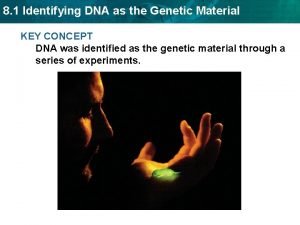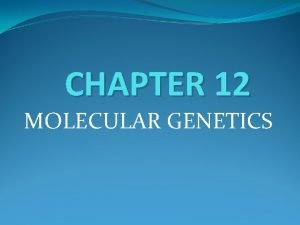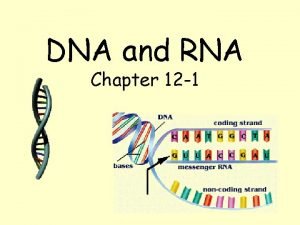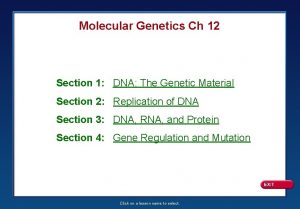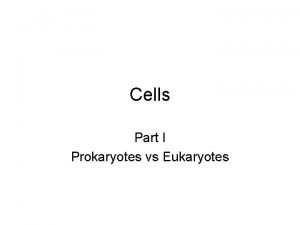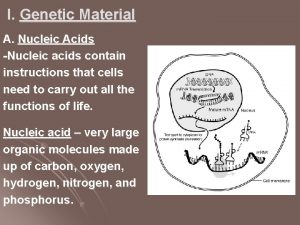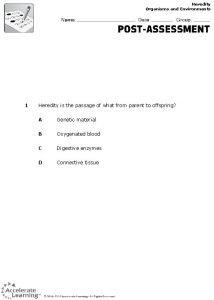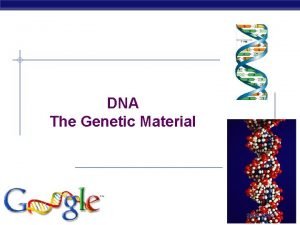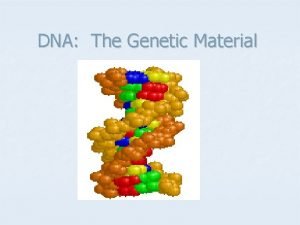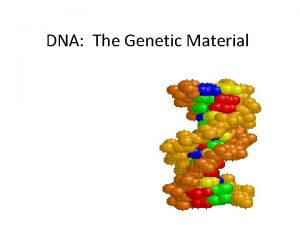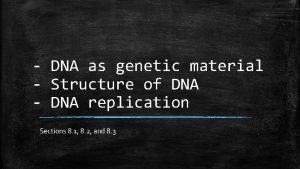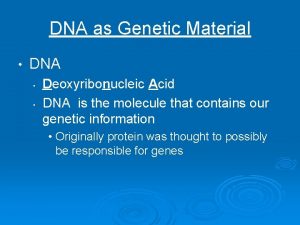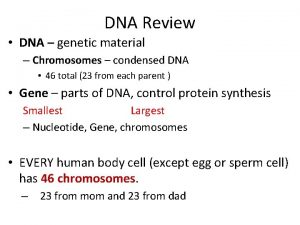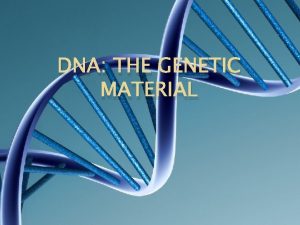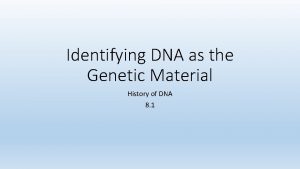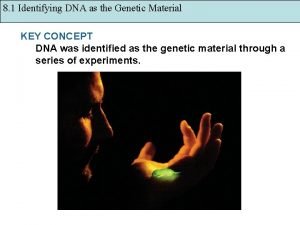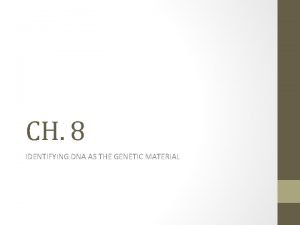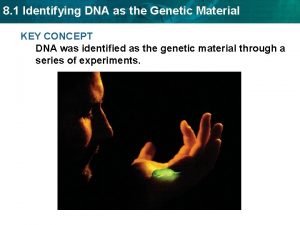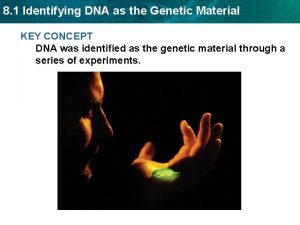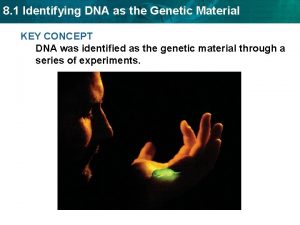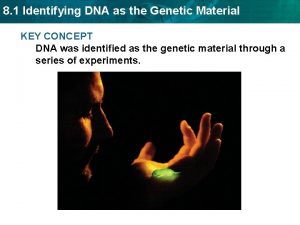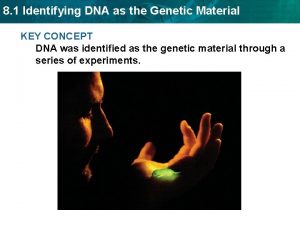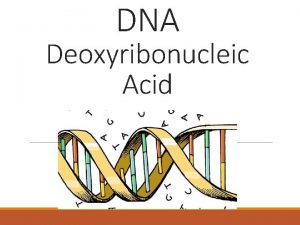DNA The Genetic Material Identifying the Genetic Material































- Slides: 31

DNA: The Genetic Material

Identifying the Genetic Material • Experiments of Griffith and Avery yielded results that suggested DNA was genetic material (1944)

• Hershey & Chase used the bacteriophage T 2 and radioactive labels to show that virus genes are made of DNA, not protein (1952)

• DNA stores information that tells cells which proteins to make and when to make them https: //www. youtube. com/watch? v=b. Vk 0 t w. JYL 6 Y

The Structure of DNA • Discovered by Watson & Crick in 1953 & received Nobel Prize in 1962 along with Maurice Wilkins http: //www. youtube. com/watch? v =sf 0 YXn. AFBs 8&feature=autoplay& list=PL 4900 A 106005340 D 0&lf=res ults_video&playnext=2

• • • DNA Polymer : Nucleotide Monomer Each Nucleotide has 3 parts: 1) 5 carbon sugar Deoxyribose 2) Phosphate group PO 4 3) Nitrogen Base

Nitrogen Bases Purines Adenine Guanine Pyrimidines Thymine Cytosine



A Human 30 Plant 27 Virus 21 T 30 27 22 • DNA forms a spiral ladder Double Helix • Double helix is held together by weak Hydrogen bonds • Erwin Chargaff Discovery Chargaff’s Rule A=T, G=C G 19 22 28 C 19 22 27

DNA Replication • Phase of Cell Cycle? Why replicate? • Step 1: DNA Helicase unzips DNA by breaking weak Hydrogen bonds. • Step 2: DNA polymerase adds nucleotides to exposed nitrogen bases. • Step 3: Two DNA molecules form that are identical to original.

• DNA is referred to as “Semi-conservative”, Each DNA molecule 1 template & 1 new strand • DNA polymerase proofreads DNA during its replication so that very few errors occur http: //www. youtube. com/ watch? v=zd. Dki. Rw 1 Pd. U https: //www. yout ube. com/watch? v =5 q. Srmei. Wsuc

• 500/sec bacteria • 50/sec human



Fig. 17 -4 DNA molecule Gene 2 Gene 1 Gene 3 DNA template strand TRANSCRIPTION m. RNA Codon TRANSLATION Protein Amino acid

Fig. 17 -3 a-2 • In prokaryotes, m. RNA produced by transcription is immediately translated without more processing TRANSCRIPTION DNA m. RNA Ribosome TRANSLATION Polypeptide (a) Bacterial cell

Fig. 17 -3 b-3 Nuclear envelope DNA TRANSCRIPTION Pre-m. RNA PROCESSING m. RNA TRANSLATION Ribosome Polypeptide (b) Eukaryotic cell

Transcription • http: //www. stolaf. edu/people/giannini/bi ological%20 anamations. html • Occurs in the nucleus • An RNA polymerase enzyme binds to the promoter and makes a m. RNA (messenger RNA) complementary to the DNA gene

Translation • Occurs in the cytoplasm • m. RNA carries the code from the DNA • Amino acids are assembled to synthesize proteins at ribosomes

Translation • t. RNA (transfer RNA) carries amino acids, which bind to threeletter nucleotide sequences on the m. RNA (codons)


http: //www. youtube. com/watch? v=1 fi. Jupfb Spg&feature=related http: //www. stolaf. edu/people/giannini/flash animat/molgenetics/translation. swf

m. RNA: AUG CCG AUC AUG UAA

Fig. 17 -25 DNA TRANSCRIPTION 3 l Po A y- RNA polymerase 5 RNA transcript RNA PROCESSING Exon RNA transcript (pre-m. RNA) Intron Aminoacyl-t. RNA synthetase y-A Pol NUCLEUS Amino acid CYTOPLASM AMINO ACID ACTIVATION t. RNA m. RNA Growing polypeptide 3 p Ca A P E A y- Activated amino acid Ribosomal subunits l Po Cap 5 TRANSLATION E A Codon Ribosome Anticodon

Mutation • Mutation – a change in the DNA http: //www. bing. com/videos/sear ch? q=DNA+mutation+animation& mid=9 A 0 A 3 B 1 F 3015 EFDFB 4889 A 0 A 3 B 1 F 3015 EFDFB 488&view= detail&FORM=VIRE 3&adlt=strict

mutations • • The cat ate the mouse Tec ata tet hem ouse (deletion) Thh eca tat eth emous (addition) The rat ate the mouse (substitution)

• Effects of change made in the protein can vary – Neutral mutation No effect occurs when the mutation in the DNA does not change the amino acid that is called for – If one base is added (insertion) or deleted (deletion), you get a frameshift mutation • Most devastating http: //highered. mcg rawhill. com/sites/00725 56781/student_vie w 0/chapter 11/anim ation_quiz_4. html

https: //www. youtube. com/watch? v=qe 59 ar. GZmg • Sickle cell • Cystic fibrosis https: //www. youtube. com/watch? v=q. V 30 Zy n. AJfw • Cancer https: //www. youtube. com/watch? v=LEp. TT olebqo

GATCTCTTAGGGTCTTACGCT • CUAGAGAAUCCCAGAAUGCGA • LEUCINE, GLUTAMIC ACID, ASPARAGINE, PROLINE, ARGININE, METHIONINE, ARGININE • CUAGAGAAUACCAGAAUGCGA • LEUCINE, GLUTAMIC ACID, ASPARAGINE, THREONINE, ARGININE, METHIONINE, ARGININE

 Section 1 identifying dna as the genetic material
Section 1 identifying dna as the genetic material Chapter 12 section 1 dna the genetic material
Chapter 12 section 1 dna the genetic material Chapter 12 section 1 dna the genetic material
Chapter 12 section 1 dna the genetic material Chapter 12 molecular genetics
Chapter 12 molecular genetics Chapter 12 dna the genetic material
Chapter 12 dna the genetic material Chapter 12 section 1 dna the genetic material
Chapter 12 section 1 dna the genetic material Identifying and non identifying adjective clauses
Identifying and non identifying adjective clauses Non identifying adjective clauses examples
Non identifying adjective clauses examples Identifying and non identifying adjective clauses
Identifying and non identifying adjective clauses A gene pool consists of
A gene pool consists of Founder effect
Founder effect Genetic drift vs genetic flow
Genetic drift vs genetic flow Genetic programming vs genetic algorithm
Genetic programming vs genetic algorithm Genetic programming vs genetic algorithm
Genetic programming vs genetic algorithm Enzyme involved in dna replication
Enzyme involved in dna replication Dna rna protein synthesis homework #2 dna replication
Dna rna protein synthesis homework #2 dna replication Bioflix activity dna replication dna replication diagram
Bioflix activity dna replication dna replication diagram Replication
Replication Coding dna and non coding dna
Coding dna and non coding dna Chapter 12 section 1 the genetic material
Chapter 12 section 1 the genetic material Which part of the cell contains genetic material
Which part of the cell contains genetic material Genetic material
Genetic material Heredity is best described as the
Heredity is best described as the Genetic material
Genetic material Which part of the cell contains genetic material
Which part of the cell contains genetic material What is real culture
What is real culture Geometric symbol
Geometric symbol All groups create norms to enforce their cultural values.
All groups create norms to enforce their cultural values. Material usage variance = material mix variance +
Material usage variance = material mix variance + Classify the materials as useful or harmful
Classify the materials as useful or harmful Non material culture
Non material culture Thế nào là mạng điện lắp đặt kiểu nổi
Thế nào là mạng điện lắp đặt kiểu nổi
